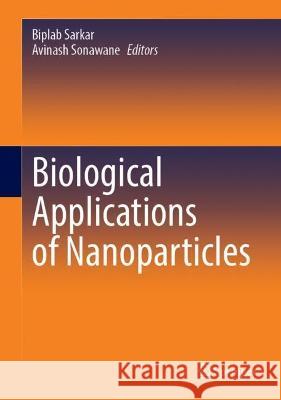Biological Applications of Nanoparticles » książka



Biological Applications of Nanoparticles
ISBN-13: 9789819936281 / Angielski
Biological Applications of Nanoparticles
ISBN-13: 9789819936281 / Angielski
(netto: 460,04 VAT: 5%)
Najniższa cena z 30 dni: 462,63
ok. 22 dni roboczych
Dostawa w 2026 r.
Darmowa dostawa!
Chapter 1_Fundamentals and Analytical Techniques for Biological Applications of Nanomaterials.- Chapter 2_Emerging applications of nanotechnology in human welfare with special reference to biomedical issues.- Chapter 3_Nanotechnology in healthcare.- Chapter 4_Nanotechnology on disease therapy and diagnostics.- Chapter 5_Nanovaccines.- Chapter 6_Role of biogenic inorganic nanomaterials as drug delivery systems.- Chapter 7_Nano-Electronics on medical applications.- Chapter 8_Nanotechnology in agricultural applications.- Chapter 9_Nanotechnology application in plant and agriculture Biotechnology.- Chapter 10_MOF: A new age smart material as nanocarriers for fertilizer and pesticides.- Chapter 11_Unravelling Algal Nanobionics for the Sustainable Production of Bioactive Compounds.- Chapter 12_Nanotoxicological issues in agriculture and related regulatory framework. –Chapter 13_Nanotechnology application on veterinary science.- Chapter 14_Nanotechnology application on fishery.- Chapter 15_Nanotechnology in food preservation.- Chapter 16_Nanotechnology in Environmnetal application.- Chapter 17_Nanotechnology application on aquatic environmental management.- Chapter 18_Nanobiosensor on environmental application.- Chapter 19_DNA and protein nanotechnology.- Chapter 20_Nanotechnology and Bioinformatics.- Chapter 21_Intellectual property management in nano-biology research.- Chapter 22_Current status and future perspectives of nano-biobusiness.
Dr. Biplab Sarkar is currently working as Principal Scientist(Nanobiotechnology) at ICAR-Indian Institute of Agricultural Biotechnology, Ranchi, Jharkhand. His group is focusing nanotechnology driven research for agricultural benefits. He has published more than forty-five international papers, and worked at ‘Centre of excellence (COE)’, Nanotech., AIT, Thailand on nanoparticle synthesis and characterization. He executed two DST and two ICAR institute funded projects on nano-formulations and nano-encapsulation for agricultural use. His group developed novel methods of formulating anti-bacterial nanosilver from rohu waste-tissues (Patent a.-3255/Mum/2012) and nanocomposite hydrogel for wound healing (Patent a.-9172/2019-KOL). First time, he reported the growth promoting role of nanosilver, unleashed the dose dependent molecular activity of magnesium and iron nanoparticles in zebra fish, and framed the futuristic application of nanoscale selenium and zinc. He also worked on nano-zeolite, nano-hydrogel, nanoliposomes for use in farming sector.
Prof. Avinash Sonawane is working as professor at IIT-Indore. He is elected as the fellow of Royal Society of Biology (FRSB), UK; Humboldt Fellow, Germany; SwissNational Science Fellow: Switzerland; EMBO Fellow:Germany; JSPS Fellow:Japan. He has published more than fifty international research articles and four patents. His group has identified several novel Mycobacterium tuberculosis virulence and antigenic determinants that subvert host innate immune responses such as autophagy, oxidative stress, peroxisome biosynthesis, host antimicrobial peptide synthesis, genomic stability and T-cell activation using mice and zebrafish infection models. They demonstrated that nanoparticle encapsulated anti-TB drug delivery through polymer, chitosan etc. admixed with metal and metal oxide nanoparticles can exhibited targeted delivery and higher efficacy in the animal models.
This textbook for graduate and postgraduate students provides comprehensive applications of nanoparticles in medicine, agriculture, and environmental sciences. The initial chapter covers basic topics related to types, synthesis, structure, and properties of various nanoparticles. It further discusses the wide range of applications of nanoparticles in medicine, agriculture, and the environment. The book presents nano-electronic biosensors that are used to diagnose and monitor the progression of human diseases. It summarizes the opportunities and challenges of nanotechnology in the agriculture and food sector highlighting the scientific, technical, regulatory, safety, and societal impacts.
Additionally, it illustrates the applications of nanotechnology in the field of aquaculture medicine,bioinformatics and food technology. The textbook examines the development and administration of nano- medicines , their applications, advantages, and limitations for the treatment and prophylaxis of a broad range of diseases. Lastly, the textbook explores the recent advances in the field of nanobusinessand nanotechnology issues in intellectual property management( IPR)..
1997-2025 DolnySlask.com Agencja Internetowa
KrainaKsiazek.PL - Księgarnia Internetowa









